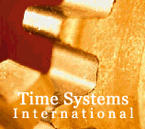Produce a More Accurate Payroll with Improved Time and Attendance
A good example of GIGO is when an employee is under or over-paid. The problem is rarely the fault of the payroll software or the payroll processing company. The problem is that bad raw data went into the payroll system in the first place. For most businesses, their payroll is their single largest expense. For most service businesses, their payroll is better than half of all of their expenses. And creating accurate payroll checks for each and every employee only happens if the raw data going into the payroll system is as accurate as possible. Providing accurate raw payroll data is the niche that Times Systems International (TSI) discovered and has been serving for over eight decades. Starting with mechanical time clocks and progressing through many layers of new technologies, TSI provides its clients with systems that accurately track the time worked by not just their employees, but also by subcontractors and suppliers if they need that information. Determining just how many hours Mary worked is neither a simple nor an easy task. For example, if Mary was asked to stay late, and she worked 11 hours on Thursday, should she be paid overtime? The definitive answer is that it depends. Time Systems creates unique employee time tracking systems for each and every client. Generally referred to as “time and attendance,” TSI’s clients run the gamut from prisons to hospitals, manufacturers to service companies, and government agencies, private industry and the not-for-profit sector. In fact, the more employees a company has, the more money Time Systems International can save them on payroll over-payments! And companies with even more complicated work schedules can save even more money with TSI. So let’s get back to Mary. She worked 11 hours on Thursday, so most payroll systems would pay her for three hours of overtime. Mary worked 8 hours on Monday, Tuesday and Wednesday, and 11 hours on Thursday. However, Mary’s boss sent her home at lunchtime on Friday, so she worked just four hours that day. That’s 39 hours for the week. The law is that employees are entitled to overtime when they work over 40 hours for the week, not when they work over eight hours in a single day. Mary is entitled to be paid for 39 hours, and NO overtime. But most systems would pay her three hours of overtime! We love this one. Joe works the graveyard shift from 11:00 pm to 7:00 am, yet on this overnight shift he is only entitled to be paid for seven hours. Why? Because it is the Sunday in which we turn the clocks ahead for Daylight Savings Time. But don’t worry, when we turn the clocks back in the Fall, Joe will be paid for nine hours. |

